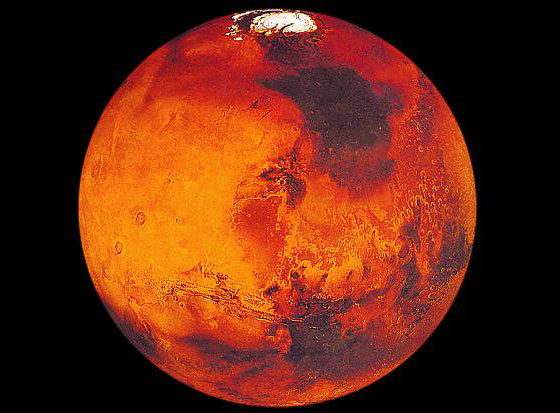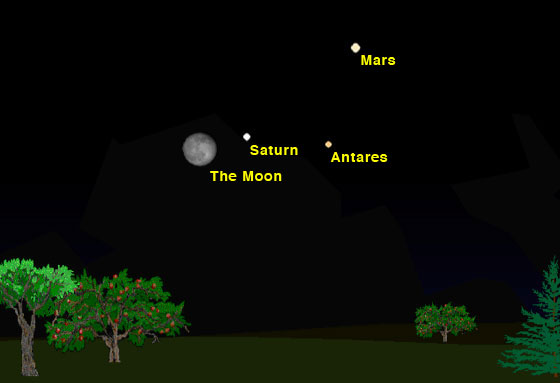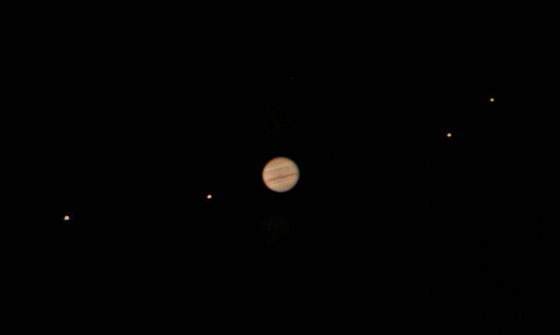The skies of May 2016 provide some wonderful celestial delights. Read on to see what you can see in the night sky this month!

See the planet Mars in the night sky in May: The brightest it’s been in over a decade!

Mars reaches “opposition” on May 22, reaching peak visibility for 2016. In fact, Mars will appear brighter than it has since 2005. “Opposition” just means that Earth is directly between Mars and the sun – Mars and the sun will be on opposite sides of Earth on May 22. So during that evening Mars will rise in the east as the sun sets in the west. On May 30 Mars will reach its closest approach to Earth for the year. The two planets will be only 46.8 million miles (75.3 million kilometers) apart – that’s about half of the distance between the Earth and the sun.
Mars will be in the constellation Scorpius for most of the month, moving into Libra in late May. Mars, Saturn and the prominent, red star Antares (in Scorpius) will form a tilted triangle over the southern horizon throughout the month.

The beautiful, ringed planet Saturn follows Mars in the night sky
 While Mars will make its brightest appearance for the year this month, Saturn follows Mars in the night sky and always puts on an impressive show through a telescope. Even small telescopes reveal this planet’s beautiful rings. If your telescope is powerful enough, you will be able to see the dark gap in the rings known as the “Cassini division,” named after the French astronomer Jean D. Cassini who discovered the gap in 1675.
While Mars will make its brightest appearance for the year this month, Saturn follows Mars in the night sky and always puts on an impressive show through a telescope. Even small telescopes reveal this planet’s beautiful rings. If your telescope is powerful enough, you will be able to see the dark gap in the rings known as the “Cassini division,” named after the French astronomer Jean D. Cassini who discovered the gap in 1675.
Look for Saturn low over the eastern horizon toward the end of May. In terms of brightness, Saturn will be second only to Mars in that part of the night sky.
Watch a shadow creep across Jupiter through your telescope!

If you have a telescope, consider viewing Jupiter over the night of May 12/13. Ganymede – one of the four large moon’s of Jupiter – will cast its shadow over the surface of the giant planet that night between 11:40 pm and 2:51 am EDT (3:40 am and 6:51 am GMT). The shadow will look like a black dot on Jupiter’s cloudy surface.
While the Earth has one moon and Mars has two, Jupiter has 67! Most are very small and cannot be seen with amateur telescopes. But amateurs can easily see Jupiter’s four largest moons, the so-called Galilean satellites, named after Galileo Galilei who observed them in 1610. The moons move so quickly that you can detect their motion over the course of an evening.

Jupiter is easy to find now. It’s in the prominent constellation Leo, which you’ll see over the southern horizon after sunset. (If you live in the southern hemisphere of Earth Leo will appear above your northern horizon.) If you have a good telescope, you’ll see not only some of the four large moons of Jupiter, but also some horizontal lines going across the surface of Jupiter. Those are its cloud bands.

Safely see Mercury cross the surface of the sun Monday, May 9

Mercury passes between Earth and the sun only about 13 times a century, its last trek taking place in 2006. Of course, one should never look at the sun without protection: Viewing this event safely requires a telescope or high-powered binoculars fitted with solar filters made of specially-coated glass or Mylar. But the safest way to view this event is by watching it online via such venues as NASA.gov and Sky & Telescope magazine.
Mercury, which is in the constellation Aries now, will appear as a small black dot as it crosses the edge of the sun and into view at 7:12 a.m. EDT (11:12 am GMT). The planet will make a leisurely journey across the face of the sun, reaching mid-point at approximately 10:47 a.m. EDT, and exiting the golden disk at 2:42 p.m EDT. The entire 7.5-hour path across the sun will be visible across the Eastern United States – with magnification and proper solar filters – while those in the West can observe the transit in progress after sunrise.
Did you know you can use the Moon to find constellations in the night sky? Follow us on Twitter where we post information each day about what constellation (area of the night sky) the Moon is in that evening.
Name A Star Live offers some really good tools to learn about the night sky and find your star’s constellation. Visit our website to learn about our Virtual Planetarium software, planisphere constellation finder, and First Light Astronomy Kit!